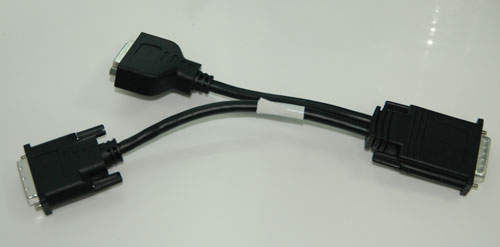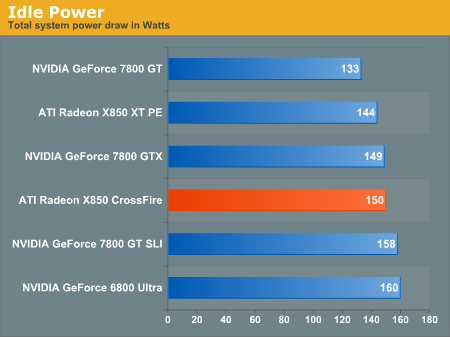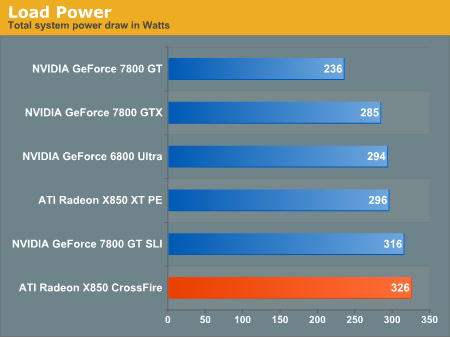ATI's X8xx CrossFire Graphics Arrive
by Derek Wilson on September 26, 2005 1:00 PM EST- Posted in
- GPUs
Hardware and Power
The components that go into a CrossFire system consist of the CrossFire master card, a slave card, a CrossFire dongle, and a motherboard with more than 1 PCI Express x16 slot. Here's the run down of our test system:AMD Athlon 64 FX-55
ATI Radeon Xpress 200 CrossFire motherboard
1GB DDR400 2:2:2:8 RAM
120GB Seagate 7200.7 HD
OCZ Powerstream 600W PSU
The CrossFire master card is basically an X850 XT with the addition of a Xilinx FPGA (for the compositing engine) and a TMDS receiver for taking input from the slave card. Instead of 2 DVI-D ports, the CrossFire master card makes use of a high speed DMS port. This connects to one port of the CrossFire dongle and takes the slave card input as well as providing the output to the monitor.

Other than that, the CrossFire card looks just like any other X850 XT out there.

The CrossFire design is fundamentally different than NVIDIA's SLI. CrossFire uses an external compositing engine while NVIDIA's is built into the GPU. ATI handles communication via TMDS output from the slave card's framebuffer, while NVIDIA built a chip to chip communications protocol for multi-GPU operation. Both vendors offer extended antialiasing modes, but ATI offers an additional rendering mode called SuperTiling which cuts each scene up into a checkerboard pattern for rendering.
On both solutions, Alternate Frame Rendering (AFR) is the fastest mode, as this is the only mode that also accelerates geometry processing. In order to learn more about the details of how CrossFire works, please check out our previous article on the subject.
As for the stress all this hardware puts on a system when it's in action, here's a comparisons of idle and load power (under Splinter Cell: Chaos Theory). Power is measured at the wall before the PSU.


While the idle power draw is slightly lower than 7800 GT SLI, the load power is the highest of any of the measured setups. 7800 GTX SLI would be higher still, but X850 XT PE Crossfire is really closer to the 6800 Ultra SLI or 7800 GT SLI, so it's not a fair comparison. We'll have to wait for R5xx and Crossfire before we can get a good idea of how Crossfire competes with 7800 GTX SLI.










76 Comments
View All Comments
Questar - Monday, September 26, 2005 - link
That's because all the video card vendors allow higher resolutions be reducing the video blanking perioed. This gives the card more time to send data, resulting in a higher available resolution.Questar - Monday, September 26, 2005 - link
Crossfire cards only use 5 watts of power!DerekWilson - Monday, September 26, 2005 - link
again ... I appologize ... I forgot to hit the update button after I entered in the power consumption.idle: 150W
load: 326W
MrSmurf - Monday, September 26, 2005 - link
That limited resolution and refresh rate is going to the achille's heal of Crossfire.bobsmith1492 - Monday, September 26, 2005 - link
I'm assuming the article is brand new and yet to be fixed, but in case no one has noticed, the charts on page 4 show the crossfire consuming no power. While I'm sure that would be everyone's goal, I don't think it's right somehow.DerekWilson - Monday, September 26, 2005 - link
very sorry -- forgot to hit update after I filled in the info